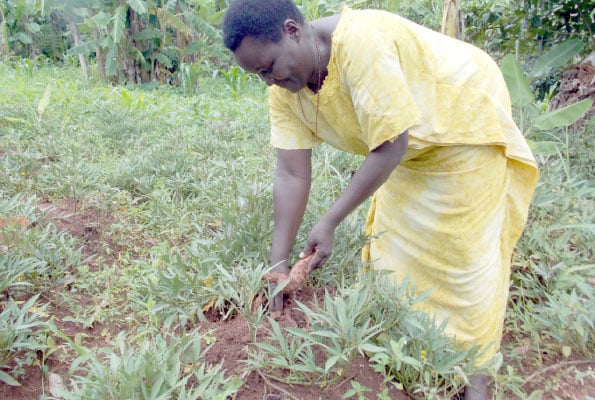Growing bio-fortified crops to boost yields and reduce ‘hidden hunger’

A farmer harvests a bio-fortified sweet potato.PHOTO/MICHAEL J SSALI
What you need to know:
People may eat food but still suffer malnutrition because of lack of vital nutrients. A way to combat this is to enhance the food with nutrients
There is such a thing known as hidden hunger. It is described as malnutrition caused by the lack of micro-nutrients in the food eaten by most poor people.
They eat staple foods such as potatoes, bananas, or cassava and get full yet they continue to suffer from malnutrition or “hidden hunger”, because such food crops do not have the vital nutrients such as iron, zinc, and Vitamin A, which the World Health Organisation categorises as the most limiting micro-nutrients to healthy living.
Well balanced
Without sufficient micro-nutrients in their diet, the children’s growth slows down, their brains do not develop properly, they may become blind, and generally they risk failure to develop strong immune systems.
To live healthy, productive lives, all people need to eat a well balanced diet, comprising a variety of food items such as fruits, vegetables, fish and animal products besides the carbohydrates.
This has proven difficult to achieve especially among poor people due to financial constraints.
However, the way to overcome this hurdle is through a process known as bio-fortification, where scientists breed staple food crops that have higher levels of the micro-nutrients: Iron, zinc, and Vitamin A. The crop into which the nutrients have been enhanced are described as bio-fortified crops.
HarvestPlus, which works with a network of agricultural and nutrition research scientists across the world, has already introduced the bio-fortified beans and sweet potatoes to farmers in Buwunga and Bukakkata sub-counties in Masaka District and Kirumba, Lwankoni and Kalisizo sub-counties in Rakai District.
A total of 4,710 farmers are already engaged in growing the beans, referred to as High Iron Beans and the sweet potatoes, referred to as Orange Fleshed Sweet Potatoes.
Improve nutrition
HarvestPlus provides the bean seeds and potato vines for distribution to the farmers through the Rakai-based NGO, Community Enterprises Development Organisation (Cedo) for them “to grow, eat, and sell in local markets.”
Ms. Rosemary Mayiga, Cedo Programme Coordinator says each farmer is given two kilogrammes of the bio-fortified beans to plant and after the harvest the farmer pays back twice as much the weight of the beans that he or she got.
Cedo, which has a seed processing plant, package them for redistribution to other farmers. The orange fleshed sweet potato vines are also distributed to the farmers on similar terms.
“Our current objective right now is to improve nutrition for children below five years and women of child bearing age,” she adds. “But in the long run we expect all the people to be eating the bio-fortified beans and potatoes for a healthy living.”
The farming communities in the named sub-counties had quite conveniently taken up and adopted the bio-fortified crops especially for their high yields and tolerance to tough climatic conditions.
Moreover, the people have always eaten beans and sweet potatoes and needed no particular persuasion to appreciate the new breeds of the same crops.
It is envisaged that within 15 years, most people in Uganda will be eating bio-fortified food crops, taking in sufficient Vitamin A, Zinc and iron, and will be a lot healthier.
[email protected]
=============================
ABOUT THE PROJECT
Community Enterprises Development Organisation (Cedo) works with agricultural researchers in Uganda to train the farmers in good agronomic practices, nutrition education, and value addition by holding regular farmers’ training sessions.
The training is done by the Community Resource Persons (CRPs) that have been trained by CEDO. The knowledge that has been obtained is quickly being shared among fellow farmers when they return to their villages.
In May, Cedo gave bicycles to the 55 selected farmers’ trainers to facilitate their transport during these knowledge dissemination activities.
-Michael J. Ssali




